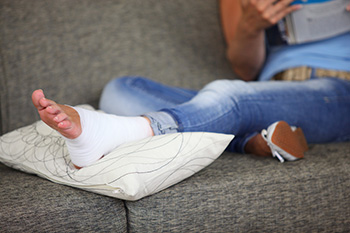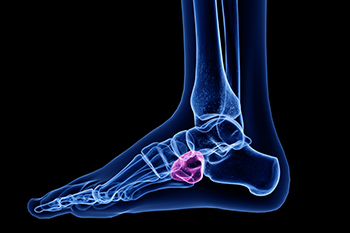Connect With Us
Blog
Items filtered by date: October 2022
Several Causes for Foot Pain

A common place for foot pain to develop is in the heel. It can indicate several foot issues, including plantar fasciitis, Achilles tendonitis, and heel spurs. All of these conditions are treatable, and a podiatrist is often contacted who can relieve the chronic pain that can be associated with these foot conditions. Flat feet may cause pain in some patients, and this is a result of little or no arch support. Wearing orthotics is a viable option that may help to diminish the pain and discomfort. A corn on the foot can bring excess pain to the patient. It is defined as a small, hardened area of skin that forms when pressure is exerted in a specific area of the foot, often the side of the pinky toe. This often happens as a result of wearing shoes and socks that are too tight. Foot pain for any reason can alter a patient's mood and can make completing daily activities challenging. A podiatrist is qualified to determine the cause of the foot pain and offer correct treatment options, so it is strongly urged that you contact this type of doctor as quickly as possible.
Foot Pain
Foot pain can be extremely painful and debilitating. If you have a foot pain, consult with Bill Brown, DPM from Brown Podiatry. Our doctor will assess your condition and provide you with quality foot and ankle treatment.
Causes
Foot pain is a very broad condition that could be caused by one or more ailments. The most common include:
- Bunions
- Hammertoes
- Plantar Fasciitis
- Bone Spurs
- Corns
- Tarsal Tunnel Syndrome
- Ingrown Toenails
- Arthritis (such as Gout, Rheumatoid, and Osteoarthritis)
- Flat Feet
- Injury (from stress fractures, broken toe, foot, ankle, Achilles tendon ruptures, and sprains)
- And more
Diagnosis
To figure out the cause of foot pain, podiatrists utilize several different methods. This can range from simple visual inspections and sensation tests to X-rays and MRI scans. Prior medical history, family medical history, and any recent physical traumatic events will all be taken into consideration for a proper diagnosis.
Treatment
Treatment depends upon the cause of the foot pain. Whether it is resting, staying off the foot, or having surgery; podiatrists have a number of treatment options available for foot pain.
If you have any questions, please feel free to contact our office located in Scranton, PA . We offer the newest diagnostic and treatment technologies for all your foot care needs.
Have I Sprained My Ankle?
 An ankle sprain happens when the ligaments that support the ankle over-stretch or tear. Ligaments connect bones to each and help to stabilize joints. Sprains injure ligaments, while strains affect muscles and tendons, but the symptoms of these two things overlap. An ankle sprain is most apt to happen from a fall, a blow to the ankle, overuse, or twisting of the ankle. It may cause intense pain in the joint, cause swelling or bruising, and make it difficult to move the ankle or walk. Sometimes it feels like a broken bone. Doctors assign a grade 1, 2, or 3 to sprains, depending on their severity. Grade 1 sprains cause mild pain and occur when the ankle ligament is stretched and may have microscopic tears. Grade 2 sprains cause moderate pain and involve partial tears to the ligament. Grade 3 sprains are severe and happen when the ligament sustains complete tears. If you have ankle pain and think you may have sprained your ankle, it is best to see a podiatrist who can make an accurate diagnosis and provide the best treatment options.
An ankle sprain happens when the ligaments that support the ankle over-stretch or tear. Ligaments connect bones to each and help to stabilize joints. Sprains injure ligaments, while strains affect muscles and tendons, but the symptoms of these two things overlap. An ankle sprain is most apt to happen from a fall, a blow to the ankle, overuse, or twisting of the ankle. It may cause intense pain in the joint, cause swelling or bruising, and make it difficult to move the ankle or walk. Sometimes it feels like a broken bone. Doctors assign a grade 1, 2, or 3 to sprains, depending on their severity. Grade 1 sprains cause mild pain and occur when the ankle ligament is stretched and may have microscopic tears. Grade 2 sprains cause moderate pain and involve partial tears to the ligament. Grade 3 sprains are severe and happen when the ligament sustains complete tears. If you have ankle pain and think you may have sprained your ankle, it is best to see a podiatrist who can make an accurate diagnosis and provide the best treatment options.
Ankle sprains are common but need immediate attention. If you need your feet checked, contact Bill Brown, DPM from Brown Podiatry. Our doctor can provide the care you need to keep you pain-free and on your feet.
How Does an Ankle Sprain Occur?
Ankle sprains take place when the ligaments in your ankle are torn or stretched beyond their limits. There are multiple ways that the ankle can become injured, including twisting or rolling over onto your ankle, putting undue stress on it, or causing trauma to the ankle itself.
What Are the Symptoms?
- Mild to moderate bruising
- Limited mobility
- Swelling
- Discoloration of the skin (depending on severity)
Preventing a Sprain
- Wearing appropriate shoes for the occasion
- Stretching before exercises and sports
- Knowing your limits
Treatment of a Sprain
Treatment of a sprain depends on the severity. Many times, people are told to rest and remain off their feet completely, while others are given an air cast. If the sprain is very severe, surgery may be required.
If you have suffered an ankle sprain previously, you may want to consider additional support such as a brace and regular exercises to strengthen the ankle.
If you have any questions please feel free to contact our office located in Scranton, PA . We offer the newest diagnostic and treatment technologies for all your foot and ankle needs.
Symptoms Associated With Cuboid Syndrome

If you care about keeping your feet healthy and happy, you may want to know about a foot condition called cuboid syndrome. This condition occurs when the cuboid bone, located on the outer side of the foot, moves out of its proper place and alignment. Typically, this may happen as a result of suffering another injury, such as twisting the ankle. If you develop cuboid syndrome, you might feel any number of symptoms. For example, you might notice redness around the affected area or diminished strength in the smaller toes. Additionally, those with cuboid syndrome also may experience difficulty in trying to move the ankle. It is also possible that cuboid syndrome can cause the feet to swell around ligaments that have been affected. If you suspect that you might have cuboid syndrome, it is wise to consult with a podiatrist for a proper diagnosis and treatment.
Cuboid syndrome, also known as cuboid subluxation, occurs when the joints and ligaments near the cuboid bone in the foot become torn. If you have cuboid syndrome, consult with Bill Brown, DPM from Brown Podiatry. Our doctor will assess your condition and provide you with quality foot and ankle treatment.
Cuboid syndrome is a common cause of lateral foot pain, which is pain on the outside of the foot. The condition may happen suddenly due to an ankle sprain, or it may develop slowly overtime from repetitive tension through the bone and surrounding structures.
Causes
The most common causes of cuboid syndrome include:
- Injury – The most common cause of this ailment is an ankle sprain.
- Repetitive Strain – Tension placed through the peroneus longus muscle from repetitive activities such as jumping and running may cause excessive traction on the bone causing it to sublux.
- Altered Foot Biomechanics – Most people suffering from cuboid subluxation have flat feet.
Symptoms
A common symptom of cuboid syndrome is pain along the outside of the foot which can be felt in the ankle and toes. This pain may create walking difficulties and may cause those with the condition to walk with a limp.
Diagnosis
Diagnosis of cuboid syndrome is often difficult, and it is often misdiagnosed. X-rays, MRIs and CT scans often fail to properly show the cuboid subluxation. Although there isn’t a specific test used to diagnose cuboid syndrome, your podiatrist will usually check if pain is felt while pressing firmly on the cuboid bone of your foot.
Treatment
Just as the range of causes varies widely, so do treatments. Some more common treatments are ice therapy, rest, exercise, taping, and orthotics.
If you have any questions, please feel free to contact our office located in Scranton, PA . We offer the newest diagnostic and treatment technologies for all your foot care needs.
Arthritis Can Cause Pain in the Feet and Ankles
A Partial or Complete Tear of the Achilles Tendon

A common Achilles tendon injury is known as Achilles tendinopathy. The Achilles tendon connects the calf muscles to the heel bone, and can become injured from overuse. This tendon is the largest one in the body, and extreme swelling may occur when it becomes injured. People who experience this type of injury often find it difficult to walk, possibly as a result of a partial or complete Achilles tendon tear. The pain is often felt in the back of the heel, which may feel tender when touched. The Achilles tendon significantly contributes to walking, as the heel is lifted when taking a step. There are some patients who experience this type of injury from the type of shoes they wear. Additionally, an Achilles tendon injury may gradually occur from medical conditions, such as arthritis, obesity, and various foot problems. If you have endured this type of injury, please contact a podiatrist, sooner rather than later, who can guide you toward correct treatments for relief.
Achilles tendon injuries need immediate attention to avoid future complications. If you have any concerns, contact Bill Brown, DPM of Brown Podiatry. Our doctor can provide the care you need to keep you pain-free and on your feet.
What Is the Achilles Tendon?
The Achilles tendon is a tendon that connects the lower leg muscles and calf to the heel of the foot. It is the strongest tendon in the human body and is essential for making movement possible. Because this tendon is such an integral part of the body, any injuries to it can create immense difficulties and should immediately be presented to a doctor.
What Are the Symptoms of an Achilles Tendon Injury?
There are various types of injuries that can affect the Achilles tendon. The two most common injuries are Achilles tendinitis and ruptures of the tendon.
Achilles Tendinitis Symptoms
- Inflammation
- Dull to severe pain
- Increased blood flow to the tendon
- Thickening of the tendon
Rupture Symptoms
- Extreme pain and swelling in the foot
- Total immobility
Treatment and Prevention
Achilles tendon injuries are diagnosed by a thorough physical evaluation, which can include an MRI. Treatment involves rest, physical therapy, and in some cases, surgery. However, various preventative measures can be taken to avoid these injuries, such as:
- Thorough stretching of the tendon before and after exercise
- Strengthening exercises like calf raises, squats, leg curls, leg extensions, leg raises, lunges, and leg presses
If you have any questions please feel free to contact our office located in Scranton, PA . We offer the newest diagnostic tools and technology to treat your foot and ankle needs.

